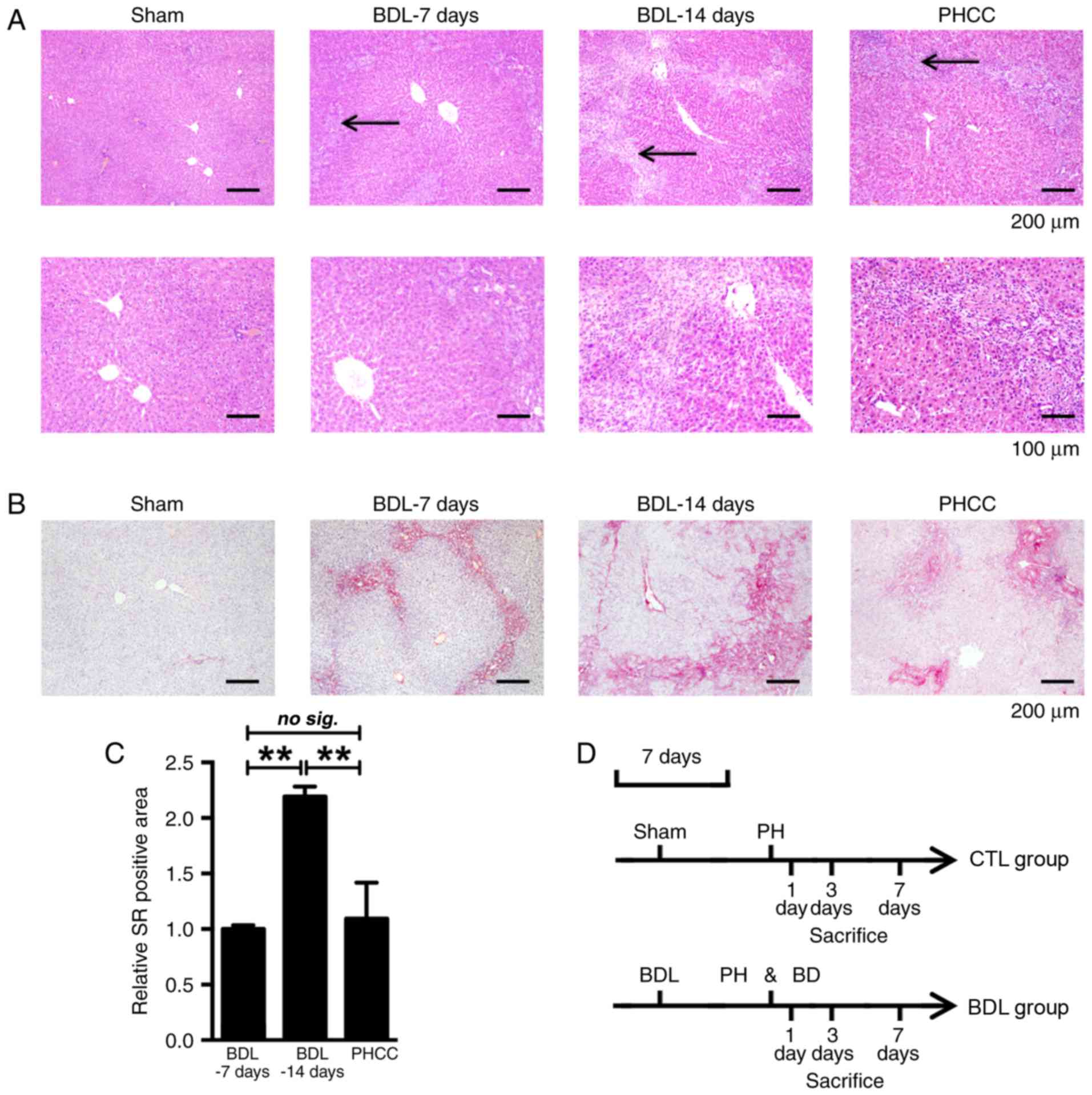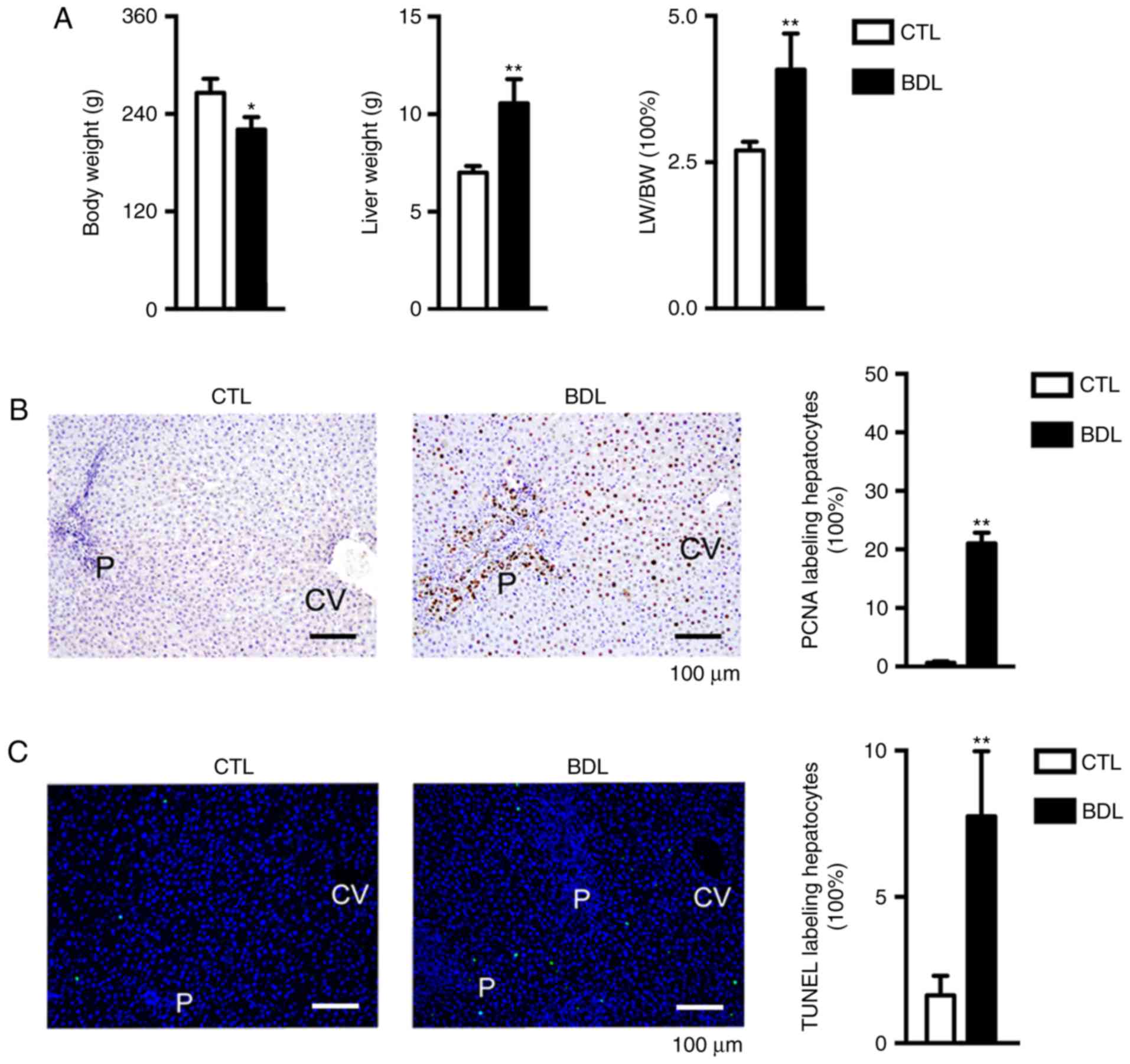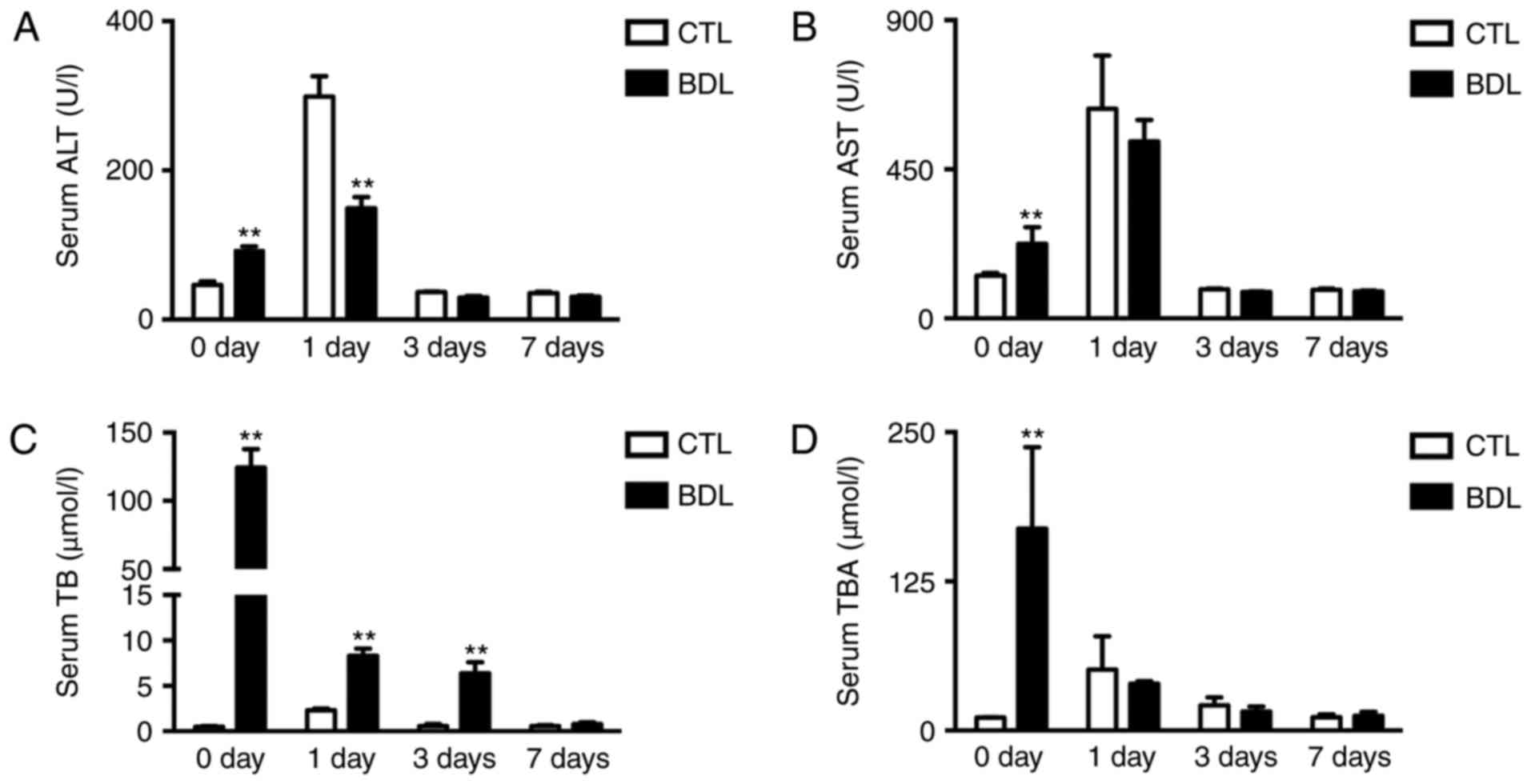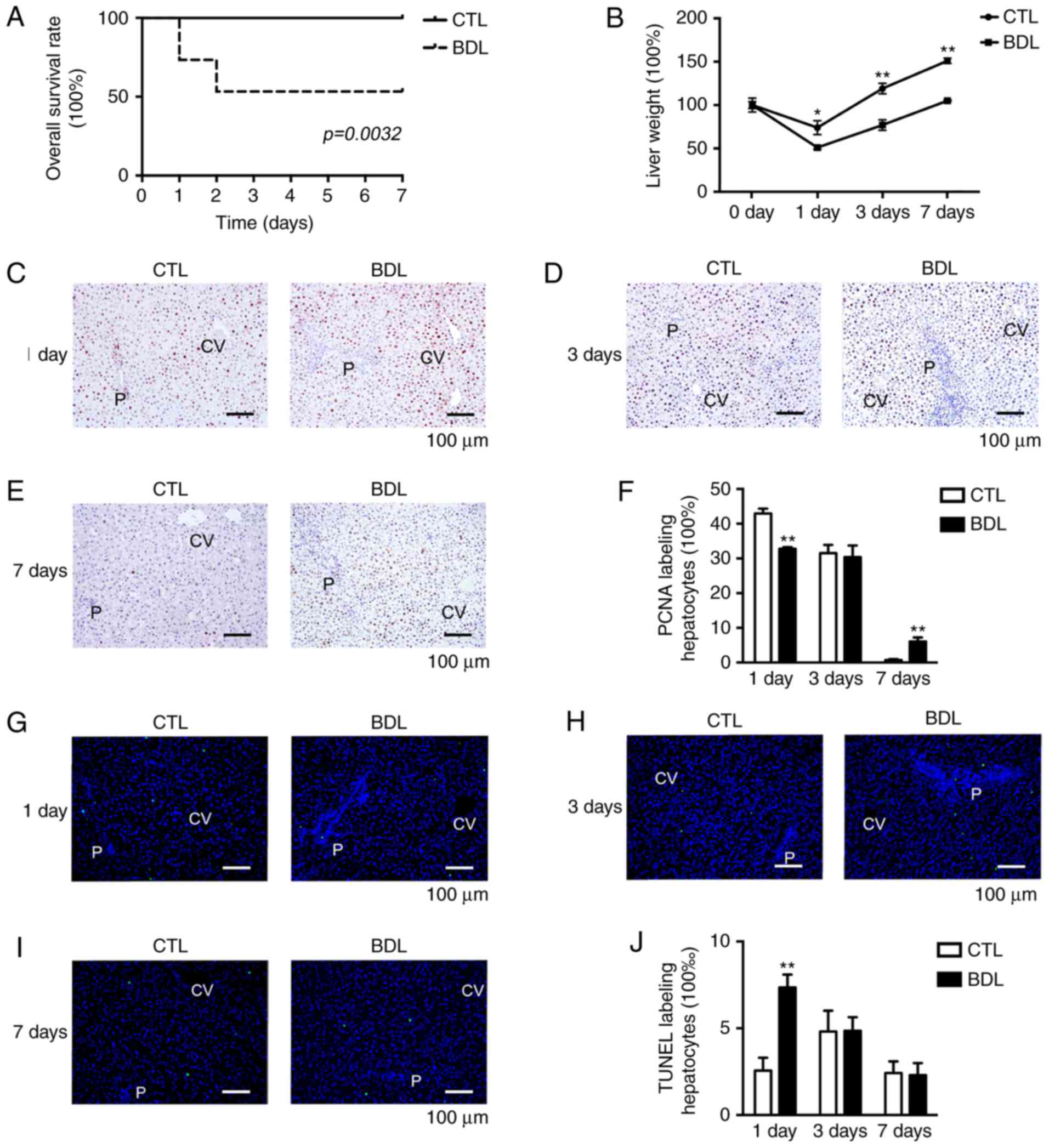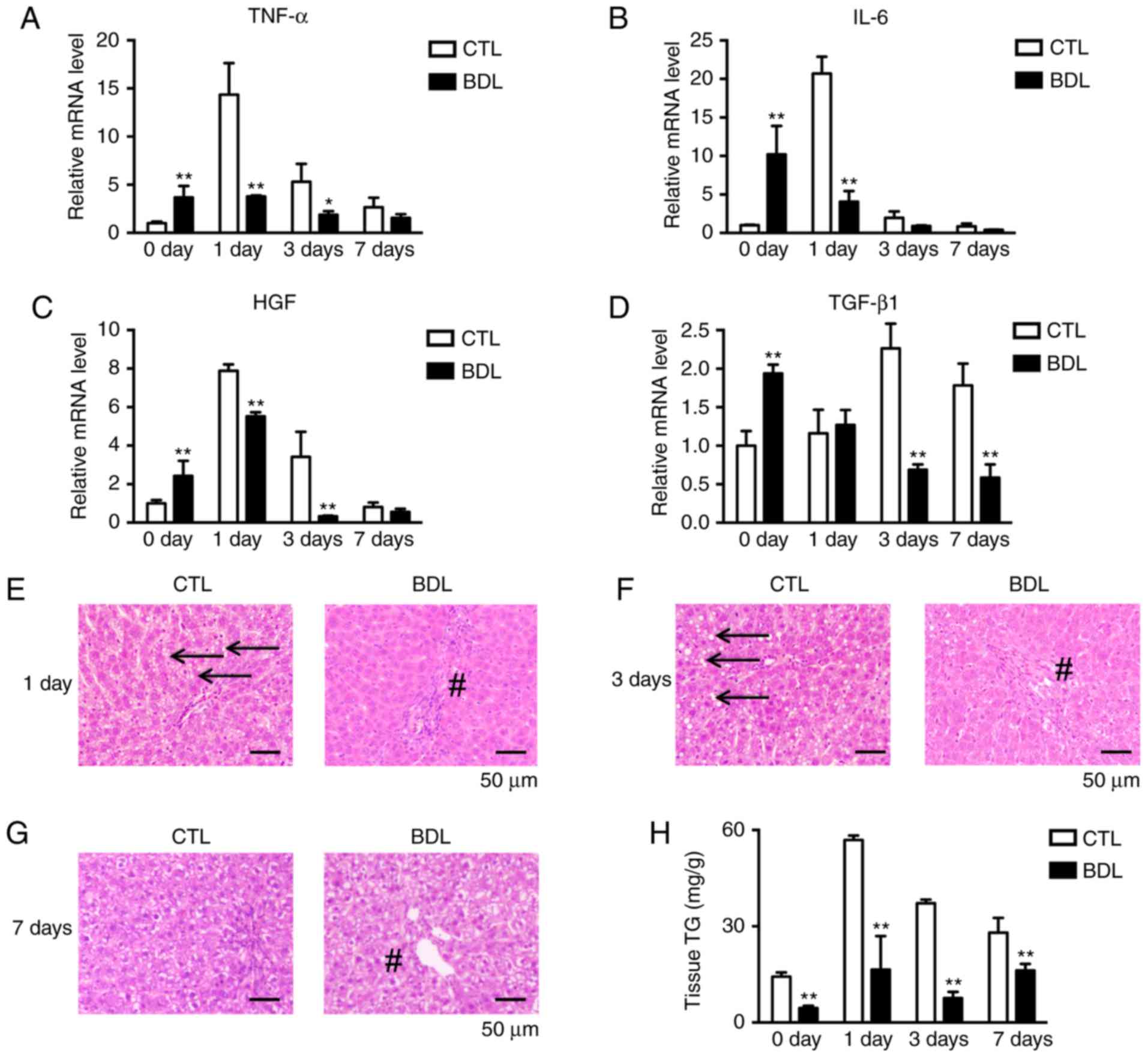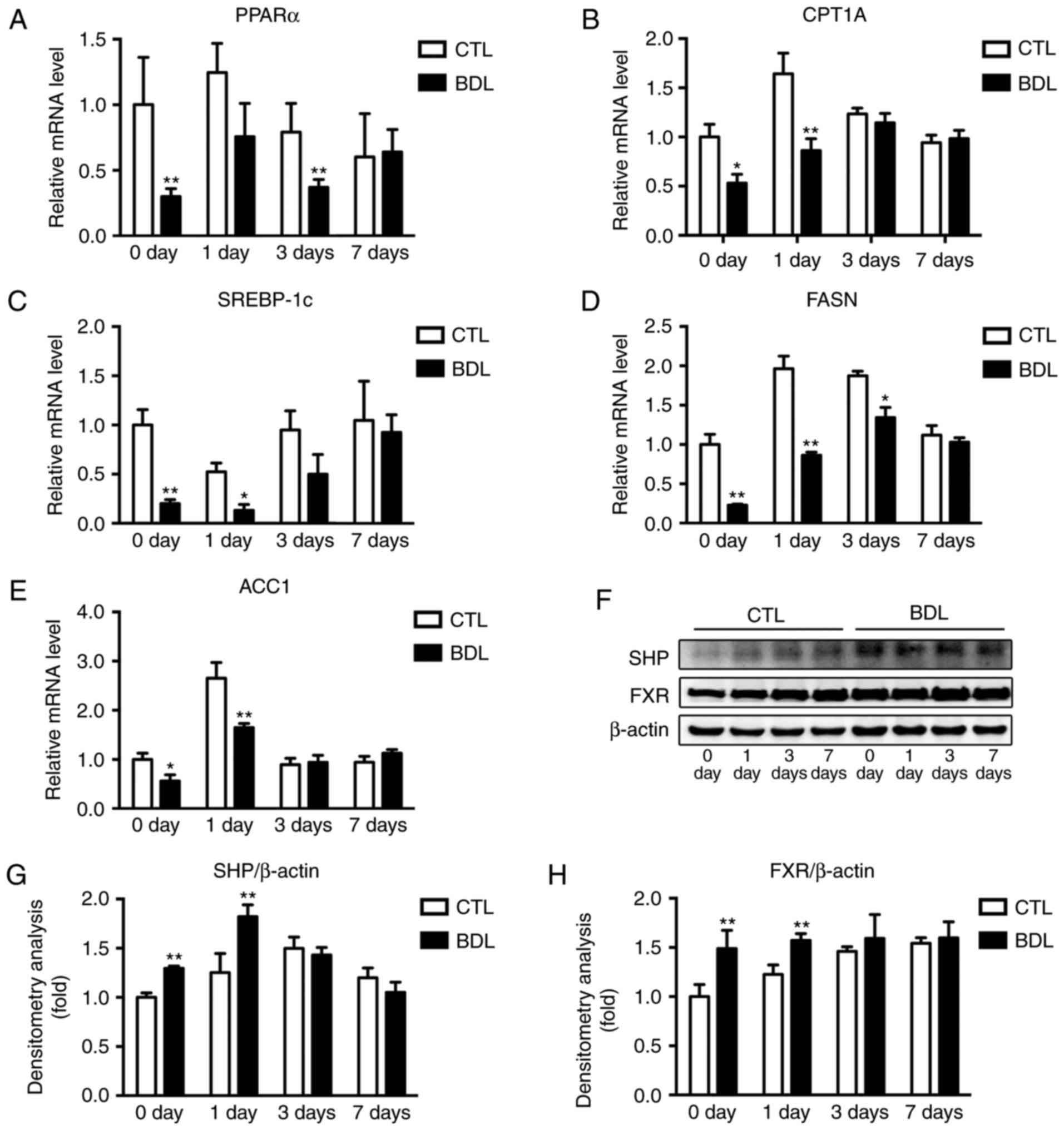|
1
|
Nagino M, Ebata T, Yokoyama Y, Igami T,
Sugawara G, Takahashi Y and Nimura Y: Evolution of surgical
treatment for perihilar cholangiocarcinoma: A single-center 34-year
review of 574 consecutive resections. Ann Surg. 258:129–140. 2013.
View Article : Google Scholar
|
|
2
|
DeOliveira ML, Cunningham SC, Cameron JL,
Kamangar F, Winter JM, Lillemoe KD, Choti MA, Yeo CJ and Schulick
RD: Cholangiocarcinoma-Thirty-one-year experience with 564 patients
at a single institution. Ann Surg. 245:755–762. 2007. View Article : Google Scholar :
|
|
3
|
Zhang Y, Hong JY, Rockwell CE, Copple BL,
Jaeschke H and Klaassen CD: Effect of bile duct ligation on bile
acid composition in mouse serum and liver. Liver Int. 32:58–69.
2012. View Article : Google Scholar
|
|
4
|
Marin JJ, Macias RI, Briz O, Banales JM
and Monte MJ: Bile acids in physiology, pathology and pharmacology.
Curr Drug Metab. 17:4–29. 2015. View Article : Google Scholar
|
|
5
|
Kennedy TJ, Yopp A, Qin Y, Zhao B, Guo P,
Liu F, Schwartz LH, Allen P, D'Angelica M, Fong Y, et al: Role of
preoperative biliary drainage of liver remnant prior to extended
liver resection for hilar cholangiocarcinoma. HPB (Oxford).
11:445–451. 2009. View Article : Google Scholar :
|
|
6
|
Yokoyama Y, Nagino M and Nimura Y:
Mechanism of impaired hepatic regeneration in cholestatic liver. J
Hepatobiliary Pancreat Surg. 14:159–166. 2007. View Article : Google Scholar
|
|
7
|
Xiong JJ, Nunes QM, Huang W, Pathak S, Wei
AL, Tan CL and Liu XB: Preoperative biliary drainage in patients
with hilar cholangiocarcinoma undergoing major hepatectomy. World J
Gastroenterol. 19:8731–8739. 2013. View Article : Google Scholar :
|
|
8
|
Iacono C, Ruzzenente A, Campagnaro T,
Bortolasi L, Valdegamberi A and Guglielmi A: Role of preoperative
biliary drainage in jaundiced patients who are candidates for
pancreatoduodenectomy or hepatic resection: Highlights and
drawbacks. Ann Surg. 257:191–204. 2013. View Article : Google Scholar
|
|
9
|
Maguchi H, Takahashi K, Katanuma A, Osanai
M, Nakahara K, Matuzaki S, Urata T and Iwano H: Preoperative
biliary drainage for hilar cholangiocarcinoma. J Hepatobiliary
Pancreat Surg. 14:441–446. 2007. View Article : Google Scholar
|
|
10
|
Takahashi Y, Nagino M, Nishio H, Ebata T,
Igami T and Nimura Y: Percutaneous transhepatic biliary drainage
catheter tract recurrence in cholangiocarcinoma. Br J Surg.
97:1860–1866. 2010. View
Article : Google Scholar
|
|
11
|
Liu F, Li Y, Wei Y and Li B: Preoperative
biliary drainage before resection for hilar cholangiocarcinoma:
Whether or not? A systematic review. Dig Dis Sci. 56:663–672. 2011.
View Article : Google Scholar
|
|
12
|
Bird MA, Lange PA, Schrum LW, Grisham JW,
Rippe RA and Behrns KE: Cholestasis induces murine hepatocyte
apoptosis and DNA synthesis with preservation of the
immediate-early gene response. Surgery. 131:556–563. 2002.
View Article : Google Scholar
|
|
13
|
Tracy TF Jr, Bailey PV, Goerke ME,
Sotelo-Avila C and Weber TR: Cholestasis without cirrhosis alters
regulatory liver gene expression and inhibits hepatic regeneration.
Surgery. 110:176–783. 1991.
|
|
14
|
Foss A, Andersson R, Ding JW, Hochbergs P,
Paulsen JE, Bengmark S and Ahrén B: Effect of bile obstruction on
liver regeneration following major hepatectomy: an experimental
study in the rat. Eur Surg Res. 27:127–133. 1995. View Article : Google Scholar
|
|
15
|
Makino H, Shimizu H, Ito H, Kimura F,
Ambiru S, Togawa A, Ohtsuka M, Yoshidome H, Kato A, Yoshitomi H, et
al: Changes in growth factor and cytokine expression in biliary
obstructed rat liver and their relationship with delayed liver
regeneration after partial hepatectomy. World J Gastroenterol.
12:2053–2059. 2006. View Article : Google Scholar :
|
|
16
|
García-Arcos I, González-Kother P,
Aspichueta P, Rueda Y, Ochoa B and Fresnedo O: Lipid analysis
reveals quiescent and regenerating liver-specific populations of
lipid droplets. Lipids. 45:1101–1108. 2010. View Article : Google Scholar
|
|
17
|
Brasaemle DL: Cell biology. A metabolic
push to proliferate. Science. 313:1581–1582. 2006. View Article : Google Scholar
|
|
18
|
Komura M, Chijiiwa K, Naito T, Kameoka N,
Yamashita H, Yamaguchi K, Kuroki S and Tanaka M: Sequential changes
of energy charge, lipoperoxide level, and DNA synthesis rate of the
liver following biliary obstruction in rats. J Surg Res.
61:503–508. 1996. View Article : Google Scholar
|
|
19
|
Moustafa T, Fickert P, Magnes C, Guelly C,
Thueringer A, Frank S, Kratky D, Sattler W, Reicher H, Sinner F, et
al: Alterations in lipid metabolism mediate inflammation, fibrosis
and proliferation in a mouse model of chronic cholestatic liver
injury. Gastroenterology. 142:140–151.e12. 2012. View Article : Google Scholar
|
|
20
|
Nagai K, Yagi S, Uemoto S and Tolba RH:
Surgical procedures for a rat model of partial orthotopic liver
transplantation with hepatic arterial reconstruction. J Vis Exp.
e43762013.
|
|
21
|
Jia WJ, Jiang S, Tang QL, Shen D, Xue B,
Ning W and Li CJ: Geranylgeranyl diphosphate synthase modulates
fetal lung branching morphogenesis possibly through controlling
K-Ras prenylation. Am J Pathol. 186:1454–1465. 2016. View Article : Google Scholar
|
|
22
|
Jiang S, Shen D, Jia WJ, Han X, Shen N,
Tao W, Gao X, Xue B and Li CJ: GGPPS mediated Rab27A
geranylgeranylation regulates beta-cell dysfunction during type 2
diabetes development via affecting insulin granule docked pool
formation. J Pathol. 2015.
|
|
23
|
Livak KJ and Schmittgen TD: Analysis of
relative gene expression data using real-time quantitative PCR and
the 2(-Delta Delta C(T)) method. Methods. 25:402–408. 2001.
View Article : Google Scholar
|
|
24
|
Chen WB, Lai SS, Yu DC, Liu J, Jiang S,
Zhao DD, Ding YT, Li CJ and Xue B: GGPPS deficiency aggravates
CCl4-induced liver injury by inducing hepatocyte apoptosis. FEBS
Lett. 589:1119–1126. 2015. View Article : Google Scholar
|
|
25
|
Fausto N, Campbell JS and Riehle KJ: Liver
regeneration. Hepatology. 43 2 Suppl 1:S45–S53. 2006. View Article : Google Scholar
|
|
26
|
Stedman C, Liddle C, Coulter S, Sonoda J,
Alvarez JG, Evans RM and Downes M: Benefit of farnesoid X receptor
inhibition in obstructive cholestasis. Proc Natl Acad Sci USA.
103:11323–11328. 2006. View Article : Google Scholar :
|
|
27
|
Halilbasic E, Baghdasaryan A and Trauner
M: Nuclear receptors as drug targets in cholestatic liver diseases.
Clin Liver Dis. 17:161–189. 2013. View Article : Google Scholar :
|
|
28
|
Soares KC, Kamel I, Cosgrove DP, Herman JM
and Pawlik TM: Hilar cholangiocarcinoma: Diagnosis, treatment
options, and management. Hepatobiliary Surg Nutr. 3:18–34.
2014.
|
|
29
|
Paik WH, Loganathan N and Hwang JH:
Preoperative biliary drainage in hilar cholangiocarcinoma: When and
how? World J Gastrointest Endosc. 6:68–73. 2014. View Article : Google Scholar :
|
|
30
|
Farges O, Regimbeau JM, Fuks D, Le Treut
YP, Cherqui D, Bachellier P, Mabrut JY, Adham M, Pruvot FR and
Gigot JF: Multicentre European study of preoperative biliary
drainage for hilar cholangiocarcinoma. Br J Surg. 100:274–283.
2013. View
Article : Google Scholar
|
|
31
|
Yazgan Y, Oncu K, Kaplan M, Tanoglu A,
Kucuk I, Dιnc M and Demιrturk L: Malignant biliary obstruction
significantly increases serum lipid levels: A novel biochemical
tumor marker? Hepatogastroenterology. 59:2079–2082. 2012.
|
|
32
|
Fuchs C, Claudel T and Trauner M: Bile
acid-mediated control of liver triglycerides. Semin Liver Dis.
33:330–342. 2013. View Article : Google Scholar
|
|
33
|
Yan XP, Wang S, Yang Y and Qiu YD: Effects
of n-3 polyunsaturated fatty acids on rat livers after partial
hepatectomy via LKB1-AMPK signaling pathway. Transplant Proc.
43:3604–3612. 2011. View Article : Google Scholar
|



